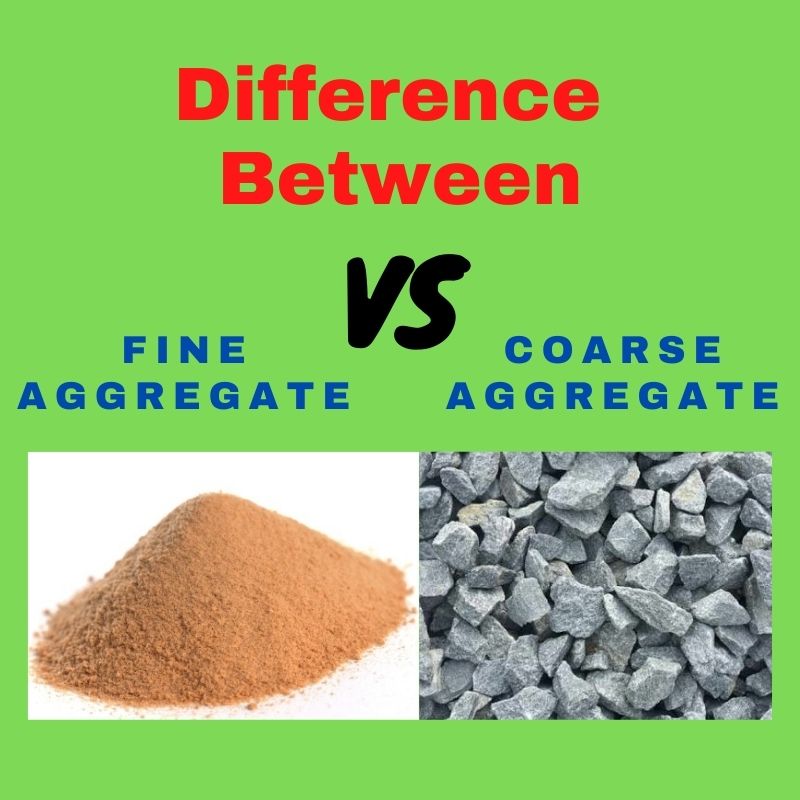Table of Contents
Aggregates are essential components of concrete. They act as inert material in concrete. Fine and coarse aggregate are two main types of aggregate for concrete. As the name indicates, they are basically classified depending on the sizes of aggregate particles.

What is an Aggregate?
Aggregates are the important constituents of the concrete which give body to the concrete and also reduce shrinkage. Aggregates occupy 70 to 80 % of the total volume of concrete. So, we can say that one should know definitely about the aggregates in-depth to study more about concrete.
(Also Read: Advantages and Disadvantages of R.C.C)
What is Fine Aggregate??
When the aggregate is sieved through a 4.75 mm sieve, the aggregate passed through it called as fine aggregate. Natural sand is generally used as fine aggregate, silt and clay have also come under this category.
What is Coarse Aggregate??
When the aggregate is sieved through a 4.75 mm sieve, the aggregate retained is called coarse aggregate. Gravel, cobble and boulders come under this category. The maximum size aggregate used may be dependent upon some conditions. In general, 40 mm size aggregate used for normal strengths and 20mm size is used for high strength concrete.
(Also Read: Quantity Analysis for Materials In 100 sq.m Cement Plaster)
Difference Between Fine and Coarse Aggregate
Fine and coarse aggregate have some major differences. Sources of main differences between deep and shallow footings are definition, size of particles, materials, sources, surface area, function in concrete, uses, etc.
In the following table the main differences between Fine and coarse aggregate are given:
| Sl No | Scopes | Fine Aggregate (FA) | Coarse Aggregate (CA) |
|---|---|---|---|
| 1 | Definition | Fine aggregates are small size filler materials in construction. | Coarse aggregates are larger size filler materials in construction. |
| 2 | Size of Particles | Fine aggregates are the particles that pass through a 4.75 mm sieve and retain on a 0.075 mm sieve. | Coarse aggregates are the particles that retain on a 4.75 mm sieve. |
| 3 | Materials | Sand, surki, stone screenings, burnt clays, cinders, fly ash, etc are used as fine aggregate in concrete. | Brick chips (broken bricks), stone chips (broken stones), gravels, pebbles, clinkers, cinders etc. are used as coarse aggregate in concrete. |
| 4 | Sources | River sand or machine sand, crushed stone sand, crushed gravel sand are the major sources of fine aggregate. | Dolomite aggregates, crushed gravel or stone, natural disintegration of rock are the major sources of coarse aggregate. |
| 5 | Surface Area | The surface area of fine aggregates is higher. | The surface area of coarse aggregate is less than fine aggregates. |
| 6 | Function in Concrete | The voids between the coarse aggregate are filled up by fine aggregate. | Coarse aggregate acts as inert filler material for concrete. |
| 7 | Uses | Fine aggregates are used in mortar, plaster, concrete, filling of road pavement layers, etc. | Coarse aggregates are mainly used in concrete, railway track ballast, etc. |
(Also Read: Instruments Used to Measure Rainfall and Snowfall)
I have already started an AutoCAD 2D, 3D and Iso-Metric Video Tutorial in our YouTube Channel, Civil Engineering Notes. If you want to learn AutoCAD, Please visit our YouTube Channel.
I hope this article will help you to know the difference between the fine and coarse aggregate. You may also want to see my other post from my Blog. If I have missed anything here, please let me know about that in the comment below this post.
Share it with your friends.
Happy Learning.
If you liked this article, then please help me to share this article with your friends through Facebook, Twitter, WhatsApp or Instagram. You can also find us on Facebook, Twitter, Instagram, Telegram Channel, YouTube Channel, and Pinterest. Also, Subscribe to our mailing list to get a new post update from us. And, do me a favour, if you find this post helpful, rate a 5 star below-